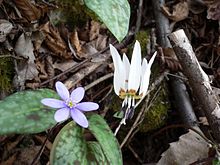- Erythronium dens-canis
-
Erythronium dens-canis 
Erythronium dens-canis (right)
and Anemone hepatica ( left)Scientific classification Kingdom: Plantae (unranked): Angiosperms (unranked): Monocots Order: Liliales Family: Liliaceae Genus: Erythronium Species: E. dens-canis Binomial name Erythronium dens-canis
L.Erythronium dens-canis (common name Dog's tooth violet or Dogtooth violet) is a small herbaceous flowering plant in the Liliaceae, native to Europe, where it is the only naturally occurring species.
It produces a solitary white, pink or lilac flower at the beginning of spring. The petals (growing to approx. 3 cm) are reflexed at the top and are yellow tinted at the base. The brown spotted leaves are ovate to lanceolate and grow in pairs. The cormous white rootstocks are oblong and resemble a dog's tooth in appearance; hence the name.
It can be found growing in shady and humid undergrowth of mountane southern Europe.
In contrast to most plants with the common name "violet", E. dens-canis is not in genus Viola. In areas of North America, several other Erythronium species (e.g. Erythronium americanum) are referred to locally as Dogtooth violet.
Uses
Erythronium dens-canis is often grown as an ornamental garden plant.
Its leaves may be consumed raw in salad, or boiled as a leaf vegetable. The corm is also the source of a starch used in making vermicelli [1].
 Media related to Dog's tooth violet (Erythronium dens-canis) at Wikimedia Commons
Media related to Dog's tooth violet (Erythronium dens-canis) at Wikimedia CommonsThis Liliales article is a stub. You can help Wikipedia by expanding it.
